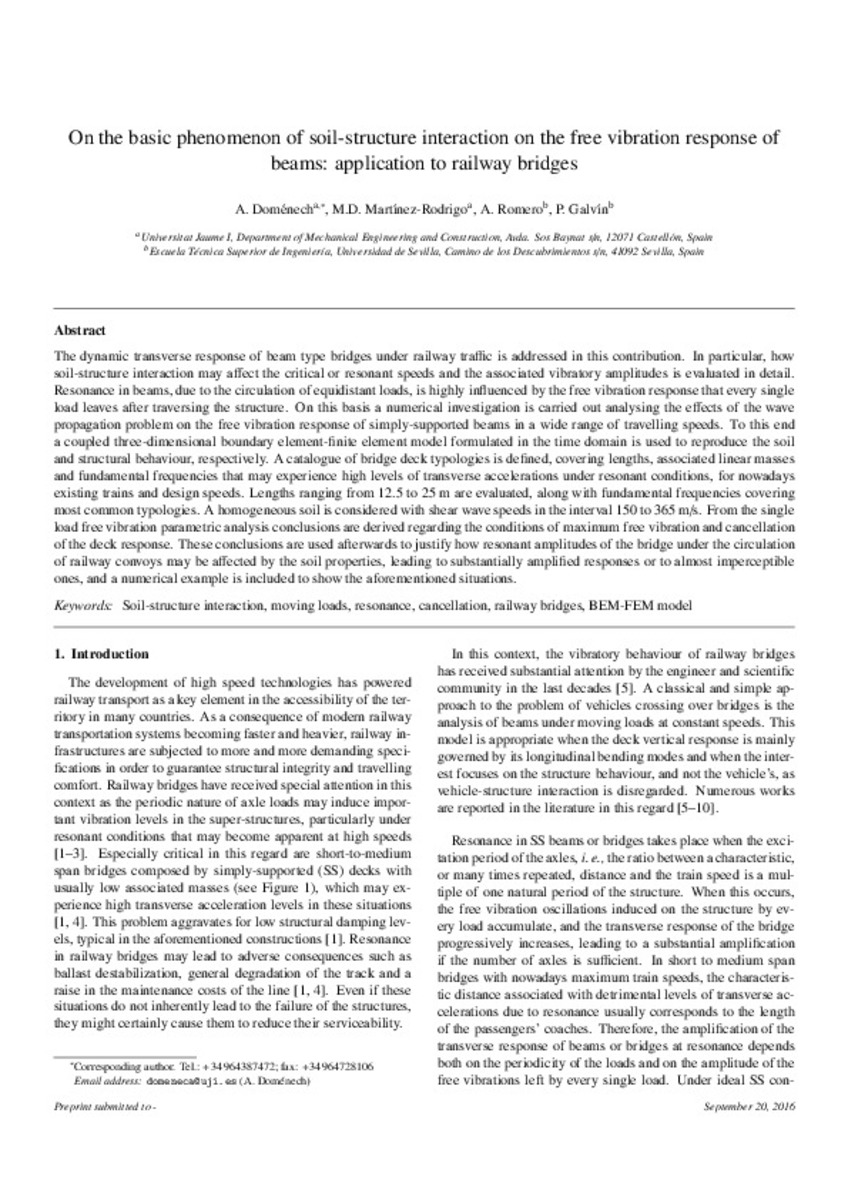Mostrar el registro sencillo del ítem
On the basic phenomenon of soil-structure interaction on the free vibration response of beams : Application to railway brigdes
| dc.contributor.author | Doménech Monforte, Alejandro | |
| dc.contributor.author | Martínez-Rodrigo, María D. | |
| dc.contributor.author | Romero Ordóñez, Antonio | |
| dc.contributor.author | Galvín, Pedro | |
| dc.date.accessioned | 2016-09-16T10:44:33Z | |
| dc.date.available | 2016-09-16T10:44:33Z | |
| dc.date.issued | 2016-10 | |
| dc.identifier.citation | DOMÉNECH, A., et al. On the basic phenomenon of soil-structure interaction on the free vibration response of beams: Application to railway bridges. Engineering Structures, 2016, vol. 125, p. 254-265. | ca_CA |
| dc.identifier.uri | http://hdl.handle.net/10234/162631 | |
| dc.description.abstract | The dynamic transverse response of beam type bridges under railway traffic is addressed in this contribution. In particular, how soil-structure interaction may affect the critical or resonant velocities and the associated vibratory amplitudes is evaluated in detail. Resonance in beams, due to the circulation of equidistant loads, is highly influenced by the free vibration response that every single load leaves after traversing the structure. On this basis a numerical investigation is carried out analysing the effects of the wave propagation problem on the free vibration response of simply-supported beams in a wide range of travelling velocities. To this end a coupled three-dimensional boundary element-finite element model formulated in the time domain is used to reproduce the soil and structural behaviour, respectively. A catalogue of bridge deck typologies is defined, covering lengths, associated linear masses and fundamental frequencies that may experience high levels of transverse accelerations under resonant conditions, for nowadays existing trains and design velocities. Lengths ranging from 12.5 to 25 m are evaluated, along with fundamental frequencies covering most common typologies. A homogeneous soil is considered with shear wave velocities in the interval 150 to 365 m/s. From the single load free vibration parametric analysis conclusions are derived regarding the conditions of maximum free vibration and cancellation of the deck response. These conclusions are used afterwards to justify how resonant amplitudes of the bridge under the circulation of railway convoys may be affected by the soil properties, leading to substantially amplified responses or to almost imperceptible ones, and a numerical example is included to show the aforementioned situations. | ca_CA |
| dc.description.sponsorShip | The first two authors would like to acknowledge the financial support provided by Universitat Jaume I under the research project P1··1B2015-54. The third and fourth authors would like to acknowledge the financial support provided by the Spanish Ministry of Economy and Competitiveness (Ministerio de Economía y Competitividad) under the research project [BIA2013-43085-P]. The authors also wish to acknowledge the support provided by the Andalusian Scientific Computing Centre (CICA). | ca_CA |
| dc.format.extent | 11 p. | ca_CA |
| dc.format.mimetype | application/pdf | ca_CA |
| dc.language.iso | eng | ca_CA |
| dc.publisher | Elsevier | ca_CA |
| dc.relation.isPartOf | Engineering Structures, October 2016, vol. 125 | ca_CA |
| dc.rights | © 2016 Elsevier Ltd. All rights reserved. | ca_CA |
| dc.rights.uri | http://rightsstatements.org/vocab/InC/1.0/ | * |
| dc.subject | Soil-structure interaction | ca_CA |
| dc.subject | Moving loads | ca_CA |
| dc.subject | Resonance | ca_CA |
| dc.subject | Cancellation | ca_CA |
| dc.subject | Railway bridges | ca_CA |
| dc.subject | BEM-FEM model | ca_CA |
| dc.title | On the basic phenomenon of soil-structure interaction on the free vibration response of beams : Application to railway brigdes | ca_CA |
| dc.type | info:eu-repo/semantics/article | ca_CA |
| dc.identifier.doi | http://dx.doi.org/10.1016/j.engstruct.2016.06.052 | |
| dc.rights.accessRights | info:eu-repo/semantics/openAccess | ca_CA |
| dc.relation.publisherVersion | http://www.sciencedirect.com/science/article/pii/S0141029616303236 | ca_CA |
Ficheros en el ítem
Este ítem aparece en la(s) siguiente(s) colección(ones)
-
EMC_Articles [811]







